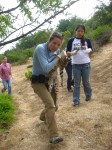Bobcat M154 weighed about 24 pounds when Laurel Serieys and Seth Riley encountered him in the wild. The pair had an hourlong window to drug the animal and sample his blood for its research on Los Angeles bobcats. They waited in the cold winter weather for the cat to regain consciousness.
“He was the biggest male we’d caught,” recalled Riley, a wildlife ecologist with the National Park Service. “We put him inside our coats to warm him up.”
Serieys would interact with many more bobcats for her research on the effects of urbanization on local bobcat populations. Her lifelong passion for researching wild felines drove her to pursue a doctoral degree in UCLA’s Department of Ecology and Evolutionary Biology and publish papers in academic journals, the most recent of which was published in February. Currently, she’s pursuing a graduate degree in South Africa studying another breed of wild cat: the caracal.
“I (had) specifically been dreaming of how urbanization was affecting wild cats,” she said, recalling her childhood. “I recognized when I was in high school that it helps to find your own path that makes you unique. You can have more of an individual impact.”
The National Park Service began studying bobcats in the Santa Monica Mountains National Recreation Area in 1996. But in 2002, large numbers of bobcats began succumbing to a disease called mange, a parasitic ailment resulting in hair loss, bacterial infection and severe emaciation. Serieys, who began working with the park service as an intern in 2006, focused on mange for parts of a project for a doctoral degree.
Serieys caught her first bobcat, B268, nine years ago.
“I probably went crazy when I saw that cat,” she said. “I was super excited, but nervous because I (had) to drug it and sample it.”
Riley said Serieys caught about 50 bobcats for her research by herself from areas such as Santa Monica, Hollywood Hills and Griffith Park. Her project focused on how freeways and pesticides induced genetic change and disease susceptibility in bobcats to conditions such as mange.
When she found traces of anticoagulant rat poison in the bloodstreams of 39 percent of 195 sampled bobcats, Serieys researched the issue and found the poison could cause immune system malfunction, making cats more susceptible to mange.
She launched a website called Urban Carnivores educating the public about her research and publicizing research on rat poison – a chemical frequently used by homeowners living on the edge of natural parkland.
“It was a travesty to me that there was no platform to deliver information to the public,” she said. “As a conservation biologist, that is the endgame.”
Joel and Kian Schulman, local activists and founders of the nonprofit Poison Free Malibu, used her research to advocate for the ban of rat poisons and bait boxes, eventually getting eight cities to ban certain types of rat poison on public property.
“She gave a fantastic talk (at a city council meeting) and they respected her,” Joel Schulman said. “She’s a powerful advocate for this.”
Serieys recalled how the mange outbreak killed 90 percent of the bobcat population in Thousand Oaks.
“I am in awe of the adaptability of these wild cats and their ability to rebound from disease,” she said. “I’m confident in their resilience. They’ll come back again.”
Although she ended her study with the National Park Service, Serieys continues to assist UCLA graduate students, including Devaughn Fraser, an ecology and evolutionary biology graduate student researching the connections between gene expression and immune function in bobcats.
“Laurel continues to advise us on sample selection. She somehow remembers every cat she captured and the events surrounding each one,” Fraser said. “She’s a continual source of support.”
But Serieys is helping Fraser from a remote distance. In November, she moved to South Africa to launch the Urban Caracal Project. The location is an opportunity for her to study how geographic isolation caused by the city of Cape Town can affect inbreeding and genetic health within caracal populations.
The project hasn’t come without its difficulties. Serieys tracks the elusive cats by GPS and visits their favorite spots after they leave, trying to think like the animal.
She said she has also faced car robberies, stolen equipment and a fire that burned one-third of her study area. She said she found the initial move stressful, not knowing the local culture or even if her project would work.
“I’m a bold person, but even that scared me,” she said.
Despite these setbacks, Serieys said the caracals still inspire her by how they survive in an isolated, sometimes violent landscape. She hopes her project will become a model for others and connect people to their backyard biodiversity.
“It’s about the choices you make. I’m living my life as I imagined it,” she said.
